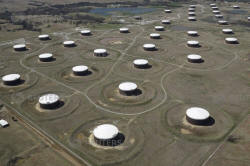Risking Trump ire, OPEC builds case for oil supply cut
 Send a link to a friend
Send a link to a friend
 [November 13, 2018]
By Alex Lawler [November 13, 2018]
By Alex Lawler
LONDON (Reuters) - OPEC built a case on Tuesday for cutting
oil output when it meets next month, warning that a supply glut could
emerge in 2019 as the world economy slows and rivals increase production
more quickly than expected.
Worried by a drop in oil prices and rising supplies, OPEC is talking
again of reducing production just months after increasing it. Such a
shift would anger U.S. President Donald Trump, who on Monday urged OPEC
not to cut supply.
In a monthly report, the Organization of the Petroleum Exporting
Countries said world oil demand next year would rise by 1.29 million
barrels per day, 70,000 bpd less than predicted last month and the
fourth consecutive reduction in its forecast.

Oil prices have dropped steeply from a four-year high above $86 a barrel
in October, pressured by concern that global demand is weakening amid
adequate supply, offsetting U.S. sanctions on Iran that have started to
cut the OPEC country's oil exports.
"Although the oil market has reached a balance now, the forecasts for
2019 for non-OPEC supply growth indicate higher volumes outpacing the
expansion in world oil demand, leading to widening excess supply in the
market," OPEC said in the report.
"The recent downward revision to the global economic growth forecast and
associated uncertainties confirm the emerging pressure on oil demand
observed in recent months."
Crude <LCOc1> maintained an earlier decline after the release of the
OPEC report, trading below $69 a barrel.
Together with Russia and other allies, OPEC had agreed in June to boost
supply after pressure from Trump to lower prices. The move partially
unwound output cuts that began in January 2017 in an effort to clear a
glut that formed in 2014-2016.
The group meets on Dec. 6 to set policy for 2019.
[to top of second column] |

Crude oil storage tanks are seen from above at the Cushing oil hub,
in Cushing, Oklahoma, March 24, 2016. REUTERS/Nick Oxford/File Photo

PRODUCTION RISING
In the report, OPEC said its oil output rose further in October by 127,000 bpd
to 32.90 million bpd after the June deal.
The biggest rises came from the United Arab Emirates and top exporter Saudi
Arabia. These helped offset declines in Venezuela, where economic crisis has
curbed output, and Iran, as buyers walked away before sanctions started this
month.
The October production rate is considerably more than OPEC expects consumers
will require next year.
OPEC said the world would need 31.54 million bpd from its 15 members in 2019,
down 250,000 bpd from last month. This suggests there will be a 1.36 million bpd
surplus in the market should OPEC keep pumping the same amount and other things
remain equal.
Saudi Energy Minister Khalid al-Falih on Monday had outlined a case for supply
restraint, saying OPEC and its allies agreed that analysis showed a need to cut
output next year by around 1 million bpd from October levels.
Oil demand is slowing as the world economy decelerates - OPEC nudged down its
2019 growth forecast in the report. The recovery in oil prices that followed the
2017 OPEC-led supply cut is still prompting more growth in rival production.
Non-OPEC supply will rise in 2019 by 2.23 million bpd, the Vienna-based
organization said, 120,000 bpd more than previously thought and far more than
the increase in world demand.
(Editing by Dale Hudson)
[© 2018 Thomson Reuters. All rights
reserved.] Copyright 2018 Reuters. All rights reserved. This material may not be published,
broadcast, rewritten or redistributed.
Thompson Reuters is solely responsible for this content.
 |